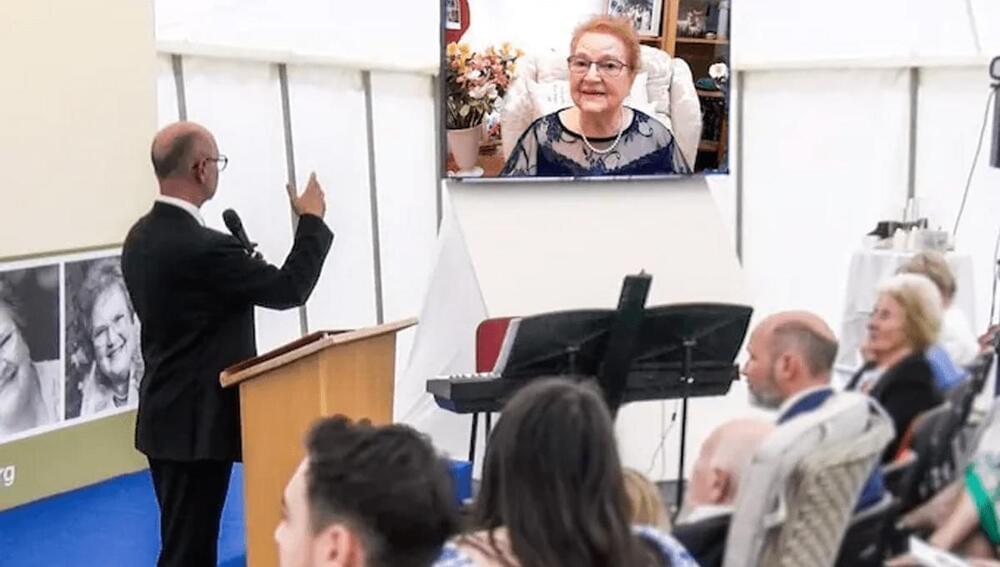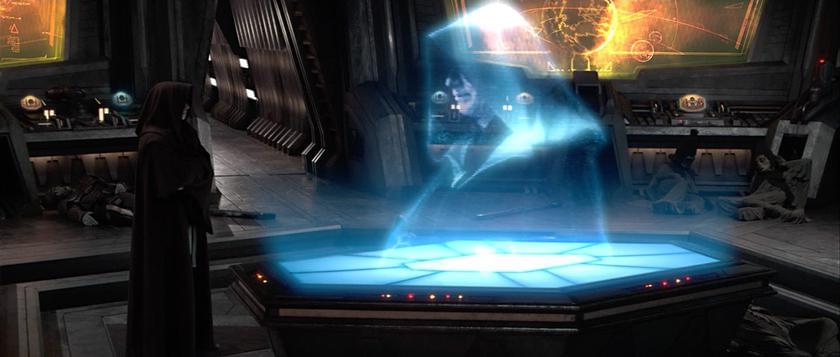Commercial Holograms may soon get into the hand of regular consumers with the help of the biggest Hologram company called Lightfield. Holography is a technique that enables a wavefront to be recorded and later re-constructed. Holography is best known as a method of generating three-dimensional images, but it also has a wide range of other applications. In principle, it is possible to make a hologram for any type of a light field.
–
TIMESTAMPS:
00:00 No longer just Science Fiction.
00:45 What is a hologram?
02:28 How do these new Holograms work?
05:56 The Future of Entertainment?
08:17 Last Words.
–
#holograms #ai #technology
Category: holograms – Page 12

Hologram Technology Allows Woman To Answer Questions At Her Own Funeral
An AI-driven chatbot technology has allowed one woman to answer questions from beyond the grave at her own funeral, with mourners able to dive into her fascinating life in a morbid but futuristic tribute. The technology was provided by her son, who runs a company that creates “holographic conversational video experiences”, and allowed Holocaust campaigner Marina Smith MBE to be “present, in a sense”, according to son Stephen Smith, reports the Telegraph.
Mrs Smith passed away in June of this year and her funeral was held shortly after in Nottinghamshire, UK. Having led a meaningful life educating people about the Holocaust, her family wished for her message to continue after her death, and the holographic experience during her funeral allowed just that.
The experience used StoryFile, an AI conversational bot that uses 20 different cameras and recordings of the subject to create a digital, holographic clone that can be interacted with. While the experience was powered by AI, the answers given to questions were entirely Mrs Smith’s own words.

Holographic Conversational Video Experience allows you to communicate with deceased relatives
The company StoryLife developed technology Holographic Conversational Video Experience that allows you to communicate with holograms of deceased relatives.
What we know
A U.S. startup has learned how to create a digital clone of a person before they die. It uses two dozen synchronized cameras to do so. They record answers to questions and then the resulting material is used to train artificial intelligence.
The Holographic Principle, Quantum Mechanics, and Simulated Reality (SR)
TWITTER https://twitter.com/Transhumanian.
PATREON https://www.patreon.com/transhumania.
BITCOIN 14ZMLNppEdZCN4bu8FB1BwDaxbWteQKs8i.
BITCOIN CASH 1LhXJjN4FrfJh8LywR3dLG2uGXSaZjey9f.
ETHEREUM 0x1f89b261562C8D4C14aA01590EB42b2378572164
LITECOIN LdB94n8sTUXBto5ZKt82YhEsEmxomFGz3j.
CHAINLINK 0xDF560E12fF416eC2D4BAECC66E323C56af2f6666.
KEYWORDS:
Scienc, Technology, Philosophy, Futurism, Simulation, Simulationism, Ockham’s Razor, Argument, Hypothesis, Anthropic Principle, Holographic Principle, Holographic Universe theory, Brain in a Vat, Brain in a Jar, Matrix, Inception, Hologram, Artificial Intelligence, Vocaloid Hologram, Reality, Ontology, Epistemology, Elon Musk, Solipsism, Illusion, Renee Descartes, George Berkeley, Materialism, Idealism, Solipsism, Cogito Ergo Sum, Esse es Percepi, Gilbert Harman, Hillary Putnam, Robert Nozick, The Experience Machine, Multiverse, Omniverse, Black Hole Hologram, Event Horizon, Singularity, Moore’s Law, Black Dual Linear Error Correcting Code, Jim James Sylvester Gates, Neil DeGrasse Tyson, Plato’s Cave, Quantum Mechanics, Schrondinger’s Cat, Observer Effect, Double-Slit Experiment, Heisenberg Uncertainty Principle, Artificial Intelligence, Quantum Superdeterminism, Free Will, Albert Einstein, Stephen Hawking, Quantum Gravity Research, Eugene Vignor, Consciousness, Fermi Paradox, SETI (search for extraterrestrial intelligence), Drake Equation, Alpha Centauri, Wave Function Collapse, Video Games, VR, Virtual Reality, God, Theology, Fine-Tuning Argument, Teleological Argument, Simulationism, Mormonism, LDS, Heavenly Father, Glitch, Dyson Sphere.
VIDEO: World’s first international holographic teleportation
Holographic teleportation is when a hologram is transmitted to a different location instantaneously.
While it is something that was only seen in SciFi movies like Star Wars, on July 27 at the Western Institute for Space Exploration (Western Space), the world’s first-ever international holoport was demonstrated.
Project leader Leap Biosystem’s co-founder, Dr Adam Sirek said that they executed two-way holographic teleportation.
The world’s first-ever international holographic teleportation has just been conducted
Holographic teleportation could solve the many issues that 2D virtual meetings have these days. Besides, you could simply beam into work while at home.
Researchers at the University of Western Ontario recently completed the world’s first-ever international holographic teleportation.
The coronavirus pandemic pushed the digitalization of many day-to-day functions of our lives. An important one among them was meeting people. Instead of having to commute to the office or travel across the oceans for a meeting, one could simply connect via an online video call and get the work done.
Even after two years, virtual meetings haven’t been able to completely replicate the ease of an in-person meeting, something that researchers are hoping holographic teleportation can solve. A combination of hologram and teleport, the technology is fondly called holoport and allows one to instantly beam the hologram of a person to a far-off location, much like the Star Trek universe.
Researchers achieve world’s first international holographic teleportation
Holographic teleportation sounds like something out of Star Wars or Star Trek, but instead of the bridge of a flashy interstellar spaceship, a world-first technological achievement took place in a nondescript boardroom on campus at Western recently.
The term holographic teleportation, or holoport, is a combination of hologram and teleport: when a hologram of a person or object is transmitted instantaneously to another location.
On the afternoon of July 27, a small group of students from the Western Institute for Space Exploration (Western Space) gathered to witness and take part in the world’s first international holoport demonstration.
Holograms get real: Startup creates objects out of light and thin air
Circa 2021
No longer relegated to science fiction, holodeck-style creations from Silicon Valley company Light Field Lab are here today.

Swave Photonics Sees Holograms Getting Real
Swave Photonics has designed holographic chips on a proprietary diffractive optics technology to “bring the metaverse to life.”
Can virtual reality become indistinguishable from actual reality? Swave Photonics, a spinoff of Imec and Vrije Universiteit Brussel, has designed holographic chips on a proprietary diffractive optics technology to “bring the metaverse to life.” The Leuven, Belgium–based startup has raised €7 million in seed funding to accelerate the development of its multi-patented Holographic eXtended Reality (HXR) technology.
“Our vision is to empower people to visualize the impossible, collaborate, and accomplish more,” Théodore Marescaux, CEO and founder of Swave Photonics, told EE Times Europe. “With our HXR technology, we want to make that extended reality practically indistinguishable from the real world.”
What does it mean to project images that are indistinguishable from reality? “It means a very wide field of view, colors, high dynamic range, the ability to move your head around an object and see it from different angles, and the ability to focus,” he said.
Scientists Are Getting Better and Better at Levitating Objects With Sound Waves
Researchers have come up with a new and improved way to levitate objects using sound waves alone, an impressive feat of mixed-reality technology that could pave the way for some seriously futuristic hologram-like displays.
As seen in a new video, the researchers were able to levitate individual polystyrene beads and water particles inside a special enclosure, making them move in three dimensions by adjusting the output of hundreds of small speakers, set up in a grid.
In one demonstration, they were even able to float a tiny piece of fabric in midair, on which they projected a movie of a leaping rabbit.